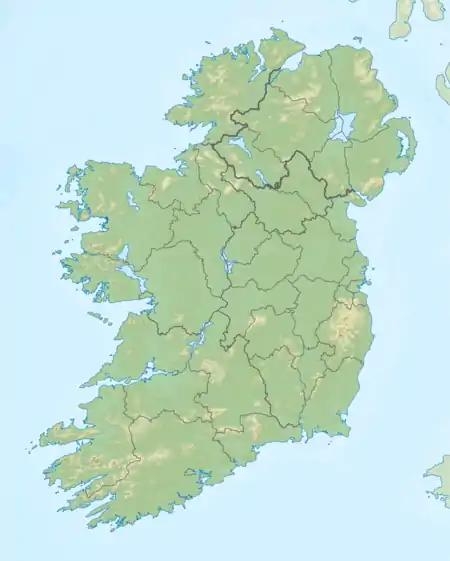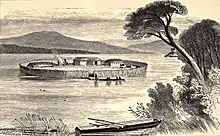St. John's Lough
St. John's Lough (Irish: Loch Eoin),[3] also known as St. John's Lake, is an irregularly shaped freshwater lake located in south County Leitrim, in northwest of Ireland.[4] The lake forms part of the wider Shannon–Erne Waterway tourist attraction. The ecology of John's Lough, and the Shannon-system, is threatened by pollution and invasive species such as curly waterweed, zebra mussel, and freshwater clam.[5][6]
| St. John's Lough | |
|---|---|
 Location in Ireland | |
| Location | County Leitrim |
| Coordinates | 54°2′25″N 7°51′47″W |
| Native name | Loch Eoin (Irish) |
| Primary inflows | Shannon–Erne Waterway |
| Primary outflows | Shannon–Erne Waterway |
| Catchment area | 22.56 km2 (8.7 sq mi) |
| Basin countries | Ireland |
| Max. length | 3 km (1.9 mi) |
| Surface area | 1.46 km2 (0.56 sq mi) |
| Max. depth | 5 m (16 ft) |
| Surface elevation | 60 m (200 ft) |
| References | [1][2] |
Etymology
Named after Irish: Eóin Baiste, meaning "John the Baptist", the lake is therefore named "the lake of John".[3][7]
Geography
St. John's Lough is a shallow freshwater lake 4 kilometres (2.5 mi) west of Ballinamore,[2] covering a surface area somewhere between 1.46 km2 (0.6 sq mi)[1] and 1.89 km2 (0.7 sq mi).[8] Saint John's Lough extends from Ballyduff Bridge in the north-east, before dividing into three broad reaches separated by narrow passes, or straits. The "Derrymacoffin Pass" connects the Ballinamore canal and northern lake portion to the central John's lough, and the "Muckross Pass" connects the central lough to the southern lough.[9] The catchment area comprises Forestry (2%), pasture (55%), and other agriculture (43%), according to CORINE data.[10] The R208 regional road follows the lakes northern boundary, crossing the Ballinamore canal at Ballyduff Bridge.
Ecology
Fish present in John's Lough include "roach-bream hybrids", Roach, Perch, Bream (1-2lbs), and Pike.[2][11] The pike population is the "native Irish strain" (Irish: liús meaning 'Irish Pike') not the other European Pike strain (Irish: gailliasc meaning 'strange or foreign fish').[5] The water quality was reported to be satisfactory c. 2001 – c. 2003 with a mesotrophic rating.[12][n 1]
Ancient Lake dwellers

Four ancient crannogs were reported at St. John's Lough.[16][n 2] The crannogs were probably occupied during at least the 13th or the early 14th century, and lands surrounding John's Lough were covered by woodland during the Middle Ages.[18]
Heritage
Museum artefacts
The following archaeological artefacts were recovered at Saint John's Lough in the 19th century, c. 1843 – c. 1852, and now preserved at the Royal Irish Academy museum, or at the National Museum of Ireland-
Ancient church
According to the Annals of the Four Masters an ancient church standing on the northern shore of Saint John's Lough (nearby where the Yellow River ["An Gheirgthigh"] enters the Lough at Irish: Tuaim Luascáin, meaning "Tomloskan") was destroyed in 1244AD.[3]
- "M1244.6: They proceeded to Ath-na-Cuirre, on the River Geirctheach, but the flood had then overflowed its banks, and they were not able to cross the ford; so they pulled down the chapel-house of St. John the Baptist, which was on the margin of the ford, that they might place its materials across the river, that the army might pass over it".[7]
Human settlements
The primary human settlements around St John's lough is Fenagh village and Ballinamore town.
See also
- List of loughs in Ireland
References and notes
Notes
- Trophic states of "Oligotrophic" and "Mesotrophic" are desirable, but freshwater lakes rated 'Eutrophic' or 'Hypertrophic' indicates pollution.[13]
- Confused folklore claimed these islands, water levels being sufficiently low, were utilised for the illicit grinding of corn possibly during penal times.[17]
Citations
- EPA 2006, pp. 13.
- anglingireland.
- logainm.ie, pp. Loch Eoin.
- Joyce 1900, pp. Atlas-Leitrim.
- Pedreschi, Kelly-Quinn, Caffrey, O’Grady, Mariani, Phillimore 2014.
- Clenaghan, Clinton, Crowe 2005, pp. 16.
- AFM, pp. 313.
- Haug 2013, pp. 59.
- MacMahon 1845, pp. 22.
- EPA 2006, pp. 32.
- discoverireland.ie 2017.
- Clenaghan, Clinton, Crowe 2005, pp. 97.
- Clenaghan, Clinton, Crowe 2005, pp. 8.
- Leitrim Observer 2014.
- Leitrim Observer 2016.
- Mulvany, Fraser, Roberts, Mulvany, O'Flaherty 1852, pp. xliii.
- Mulvany, Fraser, Roberts, Mulvany, O'Flaherty 1852, pp. xlvi.
- Mulvany, Fraser, Roberts, Mulvany, O'Flaherty 1852, pp. xlvii.
- Mulvany, Fraser, Roberts, Mulvany, O'Flaherty 1852, pp. lix.
Primary sources
- EPA (2006). "A Reference Based Typology and Ecological Assessment System for Irish Lakes" (PDF). Environmental Protection Agency (Ireland). Retrieved 8 Aug 2015.CS1 maint: ref=harv (link)
- anglingireland. "St. Johns and Kiltybardan Loughs". Inland Fisheries Ireland. Retrieved 4 Feb 2017.CS1 maint: ref=harv (link)
Secondary sources
- loganim.ie. "Loch Eoin/Saint John's Lough". Placenames Database of Ireland. Government of Ireland - Department of Arts, Heritage and the Gaeltacht and Dublin City University. Retrieved 8 Aug 2015.CS1 maint: ref=harv (link)
- Annals of the Four Masters, ed. & tr. John O'Donovan (1856). Annála Rioghachta Éireann. Annals of the Kingdom of Ireland by the Four Masters... with a Translation and Copious Notes. 7 vols (2nd ed.). Dublin: Royal Irish Academy. CELT editions. Full scans at Internet Archive: Vol. 1; Vol. 2; Vol. 3; Vol. 4; Vol. 5; Vol. 6; Indices.
- Mulvany, W. T.; Fraser, William; Roberts, Samuel; Mulvany, Thomas J.; O'Flaherty, John (1852). Appendix No. V: Notices of Antiquities Presented to the Royal Irish Academy by W. T. Mulvany, Esq., M. R. I. A., on the Part of the Commissioners of Public Works. Proceedings of the Royal Irish Academy (Report). (1850 - 1853). Royal Irish Academy. pp. xxxi–lxvi. JSTOR 20489812.CS1 maint: ref=harv (link)
- Haug, Per Ivar (2013). "Gazetteer of Ireland". Til Opplysning, A series of papers from the University Library in Trondheim, No. 16 (Third ed.). Hommelvik: UBiT, Universitetsbiblioteket i Trondheim.CS1 maint: ref=harv (link)
- discoverireland.ie (2017). "Coarse Angling Ballinamore".CS1 maint: ref=harv (link)
- Joyce, P. W. (1900). "Leitrim". Atlas and Cyclopedia of Ireland. libraryireland.com 2005-2015.CS1 maint: ref=harv (link)
- Clenaghan, Conor; Clinton, Frank; Crowe, Matthew (2005). Phosphorus Regulations National Implementation Report (PDF) (Report). Environmental Protection Agency, Office of Environmental Enforcement.CS1 maint: ref=harv (link)
- "Illegal Dumping at St. John's Lake". Leitrim Observer (15 Dec 2014 ed.). Leitrim Observer. 2014.CS1 maint: ref=harv (link)
- "Shameful act of illegal dumping at St. John's Lake, Ballinamore". Leitrim Observer (13 Feb 2016 ed.). Leitrim Observer. 2016.CS1 maint: ref=harv (link)
External links
- loganim.ie. "Tuaim Luascáin/Tomloskan". Placenames Database of Ireland. Government of Ireland - Department of Arts, Heritage and the Gaeltacht and Dublin City University. Retrieved 8 Aug 2015.CS1 maint: ref=harv (link)
- Inland Fisheries Ireland. "Ballinamore, The Fisheries".CS1 maint: ref=harv (link)